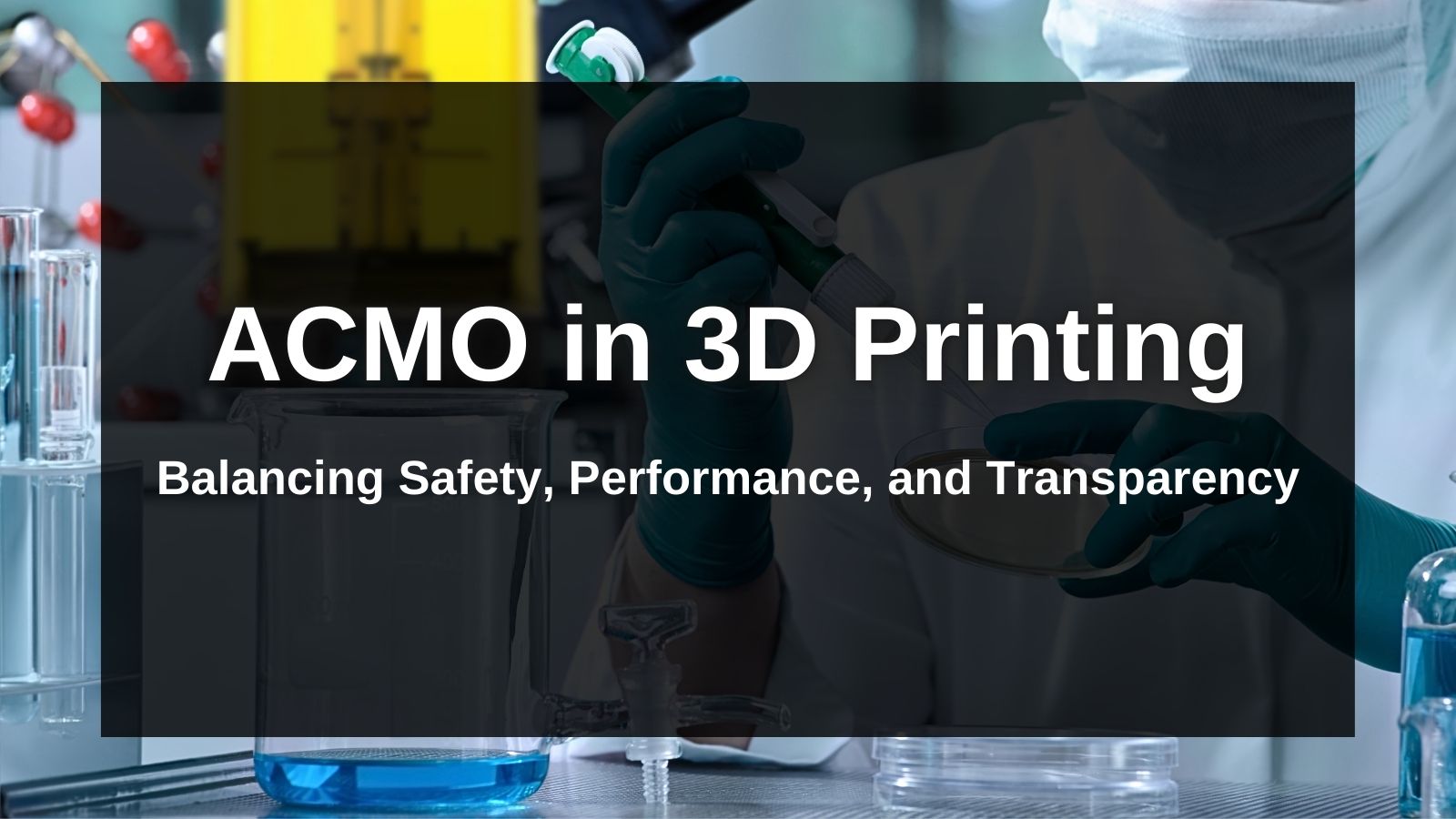3Dプリントの安全性をめぐる最近の議論、特にFormlabsが最初に問題提起した4-アクリロイルモルホリン(ACMO)の使用に関する議論に感謝いたします。業界関係者の皆様と同様に、当社は教育を通じて誤った情報に対処し、ユーザーがプリント材料やプロセスについて十分な情報に基づいた判断を下せるよう努めています。この議論に留まらず、製品への明確な安全ラベルの貼付や、レジンの安全な取り扱いと洗浄方法に関するユーザーへの継続的な教育にも取り組んでまいります。
ACMOを理解する
4-アクリロイルモルホリン(ACMO、CAS番号 5117-12-4)は、ポリマー配合におけるUV希釈剤として広く使用されている高性能アクリレートモノマーです。簡単に言えば、配合の作業性を向上させ、硬化を速めます。

ACMOは、その優れた特性、特に低粘度と高い硬化効率により、現代の製造業で広く利用されています。UV印刷されたパッケージからスマートウォッチなどの家電製品の接着剤、さらには金属コーティングや繊維に至るまで、ACMO加工された製品は、おそらく日常的に目にすることでしょう。

3DプリンティングにおけるACMO:パフォーマンス上の利点
3D 印刷アプリケーションでは、ACMO は複数の貴重な機能を果たします。
- 樹脂の粘度を下げ、印刷速度を大幅に向上させます。
- ACMO により硬化時間が大幅に短縮されるため、生産性が向上するだけでなく、エネルギー消費量と印刷失敗率も削減されます。
例えば、当社のSiraya Tech Fast樹脂は、 一般的なSaturn 3 Ultraで50µmの層あたり2.0秒で硬化しますが、 FormlabsのCreator Grey ABS-Like樹脂では、同じ層の高さで約7.5秒かかります。(下線付きのリンクをクリックすると、印刷設定のダウンロードページに移動します。)
ACMO は「安価な」成分とみなされることもありますが、実際にはプレミアム価格が設定されており、通常は Di-TMP TTA (旧称 DGPDA) や TPGDA などの他の一般的な 3D 印刷モノマーよりも 3 ~ 4 倍高価です。
ACMO(N-アクリロイルモルホリン、CAS番号:5117-12-4)の価格は、供給元、純度、購入量によって異なります。シグマアルドリッチの97%純度ACMO(阻害剤として1,000ppmのp-メトキシフェノールを含む)の価格に基づくと、以下の価格となります。

(市場状況、供給状況、注文量により価格が変動する場合がありますのでご了承ください。)
Forward AM(旧BASF)のST45(ISO10993生体適合性認証を取得しており、Nexa3DやStratasysなどの業界リーダーによって使用されている)などの高級工業用樹脂に使用されていることから、専門的な用途におけるその価値が実証されています。
安全に関する考慮事項
3Dプリントで使用されるほぼすべての材料と同様に、ACMO樹脂は専門的な化学物質であり、工場で使用する場合でも自宅で使用する場合でも、適切な取り扱い上の注意が必要です。安全プロトコルは以下のとおりです。
- 摂取を避ける
- 目と皮膚を保護する
- 接触部分をすぐに洗浄する
- 適切な換気を確保する
- 適切な個人用保護具を使用する

つまり、使用している 3D プリント樹脂に ACMO が含まれているかどうかに関係なく、上記の安全上の注意事項に従う必要があります。
レジン3Dプリントでは、洗浄用アルコールがプリント材料自体よりも重大な健康リスクをもたらすことが多いことに注意が必要です。イソプロピルアルコールなどの一般的な洗浄溶剤は、密閉された空間で吸入すると有害となる可能性があります。洗浄プロセス中は、適切な換気と呼吸保護が不可欠です。

MSDSに関する懸念と透明性への対応
FormlabsがACMOの使用について指摘したことを受け、当社は材料とサプライヤーを徹底的に調査しました。その結果、当社の樹脂に使用しているオリゴマーの一部にはACMOがプレミックスされているにもかかわらず、元のMSDS(製品安全データシート)には記載されていなかったことが判明しました。サプライヤーがオリゴマーにモノマーを添加することで粘度とコストを下げることは一般的であり、その量はオリゴマー販売業者にとって企業秘密とみなされることが多いのです。多大な圧力の後、サプライヤーから詳細が明らかになり、当社の樹脂のうち4種類が影響を受けることが判明しました。Fast、Tenacious、Simple、Buildの各樹脂のMSDSを更新しました。こちらからSiraya Tech MSDSをご覧いただけます。

プロ仕様のツールにはプロによるケアが必要
欧州のREACH登録で強調されているように、ACMOは専門用途に分類されています(EU ACMO声明) 。ここでの「専門用途」とは、ユーザーがこれらの物質の取り扱いについて適切な訓練を受け、適切な換気などの適切な安全対策が講じられた環境で作業する必要があることを意味します。
3Dプリントはますます身近なものになってきましたが、電動ノコギリやスプレー塗装機と同様に、依然として専門的なツールです。ACMOの有無にかかわらず、すべてのフォトポリマー樹脂には慎重な取り扱いが必要な化学物質が含まれているため、適切な安全プロトコルの遵守が不可欠です。
製造元の安全ガイドラインに従い、適切な保護対策を維持することで、ACMO への曝露だけでなく、洗浄溶剤への曝露というより差し迫った懸念を含む、3D 印刷プロセスにおけるあらゆる潜在的なリスクからユーザーを保護することができます。
透明性の向上を求める声
Formlabsがこの問題を提起してくださったことに敬意を表します。サプライチェーンをより深く理解する過程で、ブランド各社が「企業秘密」や「専有情報」といった表現を用いて、使用している材料のCAS番号を隠蔽していることが判明しました。安全プロトコルに従わない場合、皮膚刺激やその他の潜在的に有害な影響を引き起こす可能性のある材料はACMOだけではありません。どのような材料が使用されているかを知るために、透明性を高める必要があります。3Dプリント業界には、MSDS報告の透明性を高めるよう求めます。MSDSシートが真に有用な安全情報を提供し、ACMOであろうと他の化学物質であろうと、すべてのコンポーネントの潜在的な危険性をユーザーが理解できるような標準を目指しましょう。


1 コメント
Nathan Kozuch
Thank you for addressing this.